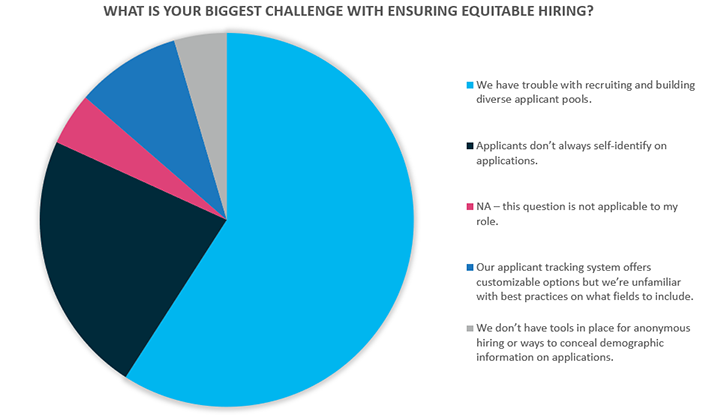Equitable hiring is a key topic in HigherEd today.
Increasing representation among employees is vital in many industries, but especially at colleges and universities. A diverse faculty and staff can shape student outcomes and experiences in many ways. HigherEd HR teams face unique challenges in recruiting and hiring diverse applicants, including limited resources, complex institutional cultures, lack of data and insights, and small applicant pools.
In our March 2022 webinar, we asked attendees what their biggest challenge was with ensuring equitable hiring. Most respondents reported that they have trouble with recruiting and building diverse applicant pools. The second most popular response was that applicants don’t always self-identify on applications.
In this webinar, PeopleAdmin experts discussed the importance of equitable hiring and addressed strategies and best practices to tackle a few of these top challenges. Read more below!
 Presentation matters when building diverse applicant pools.
Presentation matters when building diverse applicant pools.
Ircka West, PeopleAdmin Solution Engineer, noted that, when it comes to recruiting and building diverse applicant pools, it’s important to take a step back and look at your institution’s website and applicant portal.
“Candidates are looking at your site like a yearbook,” says Ircka. “Potential applicants come to your site and look for themselves to be represented. What kind of candidates do you want to attract? You should reflect that back to them. Tell your institutional DEI story, and show photos of your community. When I was working in HigherEd in my past career, I remember applying for a role at an institution that had the names and faces of their employees on the career site. That was so helpful for me to think about cultural fit.”
 Question your assumptions
Question your assumptions
Ircka encourages HR teams and hiring committees to question their assumptions about what it means to be a qualified applicant. This can come into play in a few ways.
“When it comes to resume bias, some teams will eliminate a resume if there is a single typo in it, no matter how otherwise qualified an applicant might be,” says Ircka. “Is that always the right choice? Maybe it’s time to think about an applicant beyond a spelling error—they’re likely working hard to apply to jobs, and a spelling error isn’t uncommon. Question your assumptions for the role requirements, as well. Ensure that the hiring criteria reflect the needs and the skills of the role, not just the generic assumptions for what education or work history employees ‘should’ have. The position description and review team should also recognize the value of soft skills, which can be just as important as technical skills.”
applicant might be,” says Ircka. “Is that always the right choice? Maybe it’s time to think about an applicant beyond a spelling error—they’re likely working hard to apply to jobs, and a spelling error isn’t uncommon. Question your assumptions for the role requirements, as well. Ensure that the hiring criteria reflect the needs and the skills of the role, not just the generic assumptions for what education or work history employees ‘should’ have. The position description and review team should also recognize the value of soft skills, which can be just as important as technical skills.”
 Integrate demographic information into an application
Integrate demographic information into an application
If you’re struggling to get applicants to fill out demographic information, Melissa Davis, PeopleAdmin Training Consultant, has a best practice suggestion.
“Prompt applicants to fill out demographic information as part of the application itself by adding an additional custom question,” recommends Melissa. “Even when that custom question is optional, if it’s part of the application, candidates are much more likely to fill it out. PeopleAdmin’s ATS supports these customizable questions.”
Watch on-demand!
Check out “Ensuring Equitable Hiring in HigherEd” on-demand for more insights!
